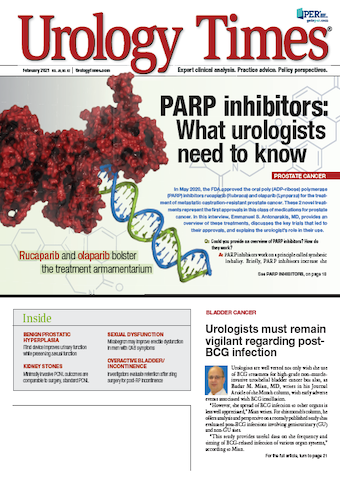Publication
Article
Urology Times Journal
Observational study results put minimally invasive PCNL in a favorable light
Author(s):
Analyses of data collected in a prospectively maintained database support the recommendation for urologists to consider the minimally invasive version of mini-percutaneous nephrolithotomy for stone removal in patients with medium-sized stones (10-20 mm).
Analyses of data collected in a prospectively maintained database support the recommendation for urologists to consider “MIP,” the minimally invasive version of mini-percutaneous nephrolithotomy (mini-PCNL), for stone removal in patients with medium-sized stones (10-20 mm), say investigators from the University of California, San Diego.
Investigators reported their initial experience with MIP in a paper published online in the Journal of Endourology.1 The study included data for 46 patients who underwent the procedure during a period from 2017 to 2019 and had reviewable CT imaging postoperatively. Initial stone size averaged 21.32 mm, measured between 1.9 and 20 mm in 29 patients (63%), and ranged up to 84 mm.
Based on postoperative CT imaging reviewable for 46 patients, 20 patients (43%) were stone-free, defined as having no identifiable fragments seen. Another 5 patients (11%) had residual fragments 0 to 2 mm, 3 patients (7%) had residual fragments 2 to 4 mm, and 18 patients (39%) had residual fragments larger than 4 mm. The stone-free rate for patients with initial stone burdens of less than or equal to 0 mm and greater than 10 to less than or equal to 20 mm was 57% and 52%, respectively, and dropped to 25% for patients with larger stones.
“The MIP procedure, which is performed using a proprietary nephroscope that uses irrigation to remove stones [Karl Storz MIP-M access sheath], has been widely used in Europe but only recently introduced in North America,” said Roger L. Sur, MD, professor of urology, University of California San Diego. “This is the first single-institution analysis of MIP cases in North America. Based on the use of a strict definition to define stone-free status, which is the main strength of our study, the outcomes achieved with MIP are comparable to the results of both retrograde intrarenal surgery and standard PCNL. Now, further studies assessing its outcomes are needed to determine the exact role of MIP in renal stone disease,” he added.
Sur and coauthor Seth Bechis, MD, performed all of the MIP procedures. The study population included equal numbers of men and women. The patients had a mean age of 60 years.
Other outcomes analyses showed that the mean operating room time was 118 minutes. The majority of patients (n=28, 61%) were discharged on the day of surgery (within 1-2 hours after the procedure), and 16 patients (35%) went home the next day. Eight patients (17%) were readmitted. Three-fourths of the complications were classified as Clavien I or II, and none were higher than Clavien III. Only 1 patient (2%) had an unplanned return to the operating room.
Sur noted that there has been an ongoing debate about the utility of mini-PCNL with respect to whether or not any differences associated with the procedure are clinically significant.
“For example, reported outcomes with mini-PCNL suggest that it decreases blood loss compared to standard PCNL, but the question of whether the difference is meaningful to patients remains unanswered,” he said. “Our observational study does not provide a direct comparison to another modality with control for key variables that can influence outcomes. Furthermore, because most patients were discharged on the day of surgery, it lacks assessment of commonly reported postoperative hematologic changes.”
These limitations are being addressed in a study undertaken by the Endourology Disease Group for Excellence Consortium. The study is a randomized controlled trial with 6 participating centers that is comparing MIP with standard PCNL and is designed to determine if the minimally invasive procedure is superior to PCNL for minimizing operative blood loss.
Disclosures: Roger L. Sur, MD, and Seth Bechis, MD, are consultants for Karl Storz.
Reference
1. Holst DD, Bechis SK, Zupkas P, et al. Minimally invasive percutaneous nephrolithotomy: initial North American experience. J Endourol. Published online November 16, 2020. doi:10.1089/end.2020.0574
































